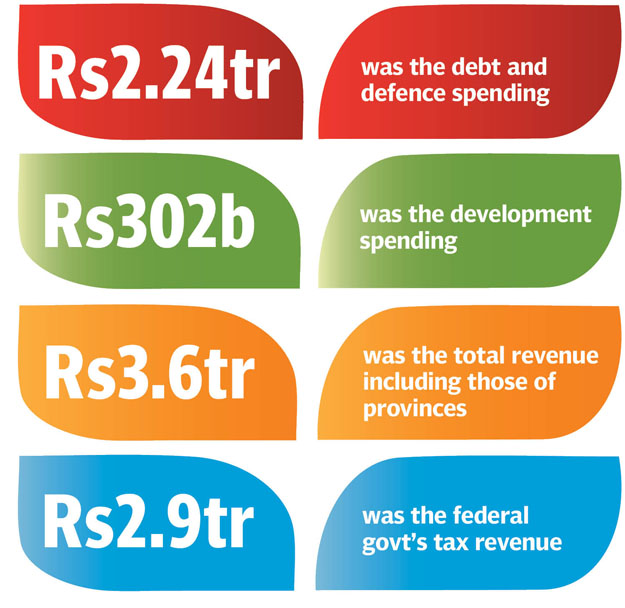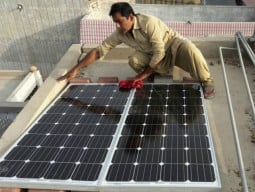
From July through March FY19, the gap between expenditures and revenues was recorded at Rs1.922 trillion or 5% of gross domestic product (GDP), according to the fiscal operations summary released by the Ministry of Finance on Tuesday.
The nine-month deficit was almost equal to the annual target of 5.1% of GDP that the government of Prime Minister Imran Khan had set after September’s mini-budget. It now seems that the deficit could hit around 7.5% of GDP by June this year. The nearly Rs2-trillion deficit for July-March of the current fiscal year was about Rs300 billion higher than the Ministry of Finance’s initial estimates. The ministry decided to fully reflect the expenditure’s position in light of an understanding reached with the International Monetary Fund (IMF).
GDP growth to remain in 2.4-2.7% range for FY19
Earlier, the ministry had estimated the nine-month deficit at Rs1.61 trillion or 4.3% of GDP. The deficit in the first nine months of FY19 was the highest for the nine-month period since 2008. Last time, in fiscal year 2007-08 the deficit had been recorded at 5% for the Jul-Mar period. The country had closed that fiscal year at a deficit of 7.4% of GDP.
Debt and defence spending consumed Rs2.24 trillion or 61.1% of the total federal expenditures, according to the Ministry of Finance. The development spending stood at just Rs302 billion or 8.2% of the federal spending.

In terms of revenues of the federal government, the debt and defence spending consumed 77.7% of the total federal government’s revenues in the Jul-Mar FY19 period.
The deficit ballooned to Rs2 trillion despite a reduction in development spending against the ceiling approved by the National Economic Council (NEC). As per NEC limits, the development spending should have been Rs472 billion in the first nine months but it stood at just Rs302 billion. The budget deficit widened despite the fact that the four provinces showed a cash surplus of Rs291 billion in the first nine months. Excluding provincial savings, the federal budget deficit jumped to Rs2.2 trillion or 5.7% of GDP in Jul-Mar FY19.
Total debt getting close to size of economy
The budget deficit and the current account deficit are the two biggest challenges for Pakistan’s economy. The Pakistan Tehreek-e-Insaf (PTI) government has so far been unable to boost FBR’s revenues and contain expenditures. The government has already announced a staff-level agreement with the IMF to cope with these challenges. It is expected that the government will introduce heavy taxation in the next budget to boost revenues as part of the IMF conditions.
The growth in expenditures was many times more than the paltry growth of less than 3% in revenues in the nine months under review.
Overall, total expenditures increased to Rs5.5 trillion in Jul-Mar FY19, higher by Rs443 billion or 8.8% over the same period of previous fiscal year. Current expenditures increased to nearly Rs4.8 trillion, which were higher by Rs723 billion or 17.7% over the corresponding period of previous year. The key reason behind the record budget deficit was the higher spending on defence and debt, and low revenues of the federal government.
Defence spending in Jul-Mar FY19 stood at Rs774.7 billion, up Rs151 billion or 24%, compared with the corresponding period of last year. Defence expenditures consumed 27% of the total federal revenues.
The IMF has introduced the primary balance condition in its 39-month programme, which will force the government either to cut the defence budget or substantially increase its revenues. Debt servicing amounted to Rs1.5 trillion, higher by Rs287 billion or 24.5%. The increase in interest rate was the key reason behind the surge in debt servicing coupled with obligations of new borrowings. Debt servicing ate up 51.8% of the total revenues. Domestic debt servicing stood at Rs1.3 trillion and external debt servicing consumed Rs182.4 billion. The currency depreciation and increase in interest rate by the central bank negatively impacted domestic and foreign debt servicing costs.
The cost of pensions also escalated, standing at Rs293 billion in just nine months. In comparison, total revenues including those of the provinces stood at Rs3.6 trillion in the first nine months, which were at the level of last year. In terms of GDP, the total revenues were equal to only 9.3%. These were 1.1 percentage point less than the corresponding period of last fiscal year. The federal government’s tax revenues increased only 2.8% to Rs2.9 trillion in Jul-Mar FY19.
Non-tax revenues stood at only Rs421.6 billion, down 16.8%. The State Bank of Pakistan transferred only Rs138 billion in profits to the federal government.
The government collected Rs141.8 billion in petroleum levy. The federal government transferred Rs1.8 trillion to the four provinces as per their share under the National Finance Commission Award. Net revenues of the federal government stood at just Rs1.5 trillion. The government obtained Rs524 billion in external loans and Rs1.4 trillion in domestic loans to bridge the budget deficit.
Published in The Express Tribune, May 22nd, 2019.
Like Business on Facebook, follow @TribuneBiz on Twitter to stay informed and join in the conversation.















1713904359-0/burn-(1)1713904359-0-270x192.webp)

























COMMENTS
Comments are moderated and generally will be posted if they are on-topic and not abusive.
For more information, please see our Comments FAQ